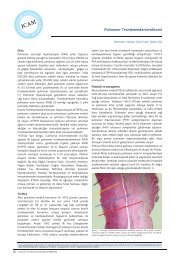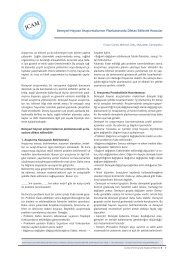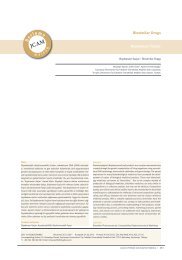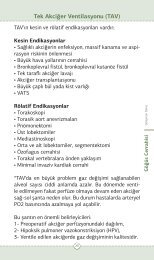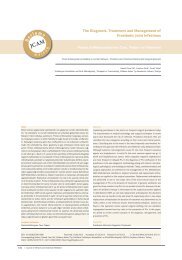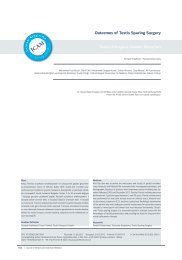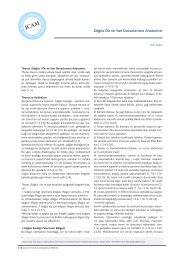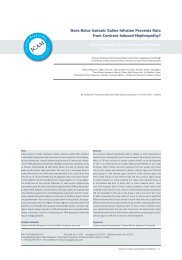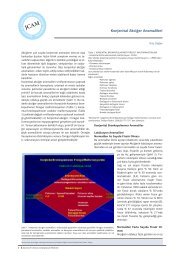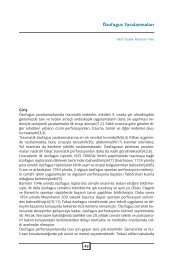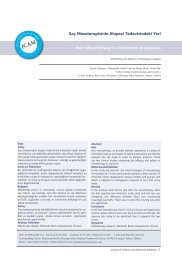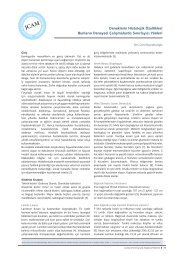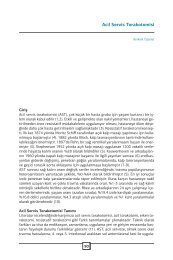Ligamentum Capitis Femoris ve Arterleri - jcam.com.tr
Ligamentum Capitis Femoris ve Arterleri - jcam.com.tr
Ligamentum Capitis Femoris ve Arterleri - jcam.com.tr
Create successful ePaper yourself
Turn your PDF publications into a flip-book with our unique Google optimized e-Paper software.
a<br />
n<br />
i<br />
j<br />
i<br />
r<br />
O<br />
h<br />
c<br />
l<br />
r<br />
a<br />
r<br />
A a<br />
e<br />
s<br />
l e<br />
þ<br />
t<br />
R<br />
ý<br />
r<br />
m<br />
a<br />
O<br />
r<br />
i<br />
g<br />
in<br />
a<br />
Özet<br />
Amaç<br />
Klinisyenler için ligamentum capitis femoris boyunca seyreden<br />
<s<strong>tr</strong>ong>ve</s<strong>tr</strong>ong> femur başını besleyen arter, aseptik avasküler nekroz hastalığından<br />
korunmada önemlidir. Bu çalışmanın amacı, arter’in<br />
seyrini, sayısını, <s<strong>tr</strong>ong>ve</s<strong>tr</strong>ong> ligament’in anatomik <s<strong>tr</strong>ong>ve</s<strong>tr</strong>ong> histolojik yapılarını<br />
araştırmaktı.<br />
Gereç <s<strong>tr</strong>ong>ve</s<strong>tr</strong>ong> Yöntemler<br />
Çalışma, 13 kadavradan alınan 26 ligament üzerinde uygulandı<br />
(8 erkek, 5 kadın). Ligament’in şekli <s<strong>tr</strong>ong>ve</s<strong>tr</strong>ong> uzunluğu incelendi. Sonra,<br />
ışık mikroskobu altında araştıtıldı.<br />
Bulgular<br />
Tüm vakalarda ligament mevcuttu. Çalışma yaşlı kadavralarda<br />
uygulanmış olmasına rağmen, tüm ligament’ler yoğun kollajen<br />
lifler <s<strong>tr</strong>ong>ve</s<strong>tr</strong>ong> bir kaç arter içeriyordu. Bu arterler kalındı. Histolojik incelemede<br />
tüm ligament’lerin dış yüzleri yoğun kollajen lifler <s<strong>tr</strong>ong>ve</s<strong>tr</strong>ong><br />
sinoviyal içeriyordu.<br />
Sonuç<br />
Arterler ligament’in içerisinde seyretmiyordu. Üstelik, arterler<br />
ligament’in üst <s<strong>tr</strong>ong>ve</s<strong>tr</strong>ong> ön bölgesinde seyrediyorlardı. Bu nedenle, addüksiyon<br />
hareketinde ligament’in hasar görmeyeceğini <s<strong>tr</strong>ong>ve</s<strong>tr</strong>ong> kan<br />
akımının kesilmeyeceğini düşünmekteyiz.<br />
Anahtar Kelimeler<br />
Femur Başı, <s<strong>tr</strong>ong>Ligamentum</s<strong>tr</strong>ong> <s<strong>tr</strong>ong>Capitis</s<strong>tr</strong>ong> <s<strong>tr</strong>ong>Femoris</s<strong>tr</strong>ong>, Fo<s<strong>tr</strong>ong>ve</s<strong>tr</strong>ong>olar Arter.<br />
22 | Journal of Clinical and Analytical Medicine<br />
<s<strong>tr</strong>ong>Ligamentum</s<strong>tr</strong>ong> <s<strong>tr</strong>ong>Capitis</s<strong>tr</strong>ong> <s<strong>tr</strong>ong>Femoris</s<strong>tr</strong>ong> <s<strong>tr</strong>ong>ve</s<strong>tr</strong>ong> <s<strong>tr</strong>ong>Arterleri</s<strong>tr</strong>ong><br />
The Ligament of Head of Femur and Its Arteries<br />
<s<strong>tr</strong>ong>Ligamentum</s<strong>tr</strong>ong> <s<strong>tr</strong>ong>Capitis</s<strong>tr</strong>ong> <s<strong>tr</strong>ong>Femoris</s<strong>tr</strong>ong> / The Ligament of Head of Femur<br />
Yalçın Kırıcı 1 , Cenk Kılıç 1 ,Emin Öztaş 2<br />
1 Departments of Anatomy,<br />
2 Histology-Embryology, Gulhane Military Medical Academy, Ankara, Turkey.<br />
DOI: 10.4328/JCAM.10.2.16 Recei<s<strong>tr</strong>ong>ve</s<strong>tr</strong>ong>d: 11.10.2009 Accepted: 04.01.2010 Printed: 01.05.2010 J.Clin.Anal.Med. 2010 ; 1(2): 22-25<br />
Corresponding author: Cenk Kılıç, Gulhane Military Medical Academy Faculty of Medicine, Department of Anatomy, 06018, Ankara, Turkey.<br />
Phone: +90 312 304 35 08 Fax: +90 312 381 06 02 E-mail: ckilicmd@yahoo.<s<strong>tr</strong>ong>com</s<strong>tr</strong>ong><br />
Abs<strong>tr</strong>act<br />
Aim<br />
The artery supply to head of femur and running along with<br />
the ligament of head of femur (ligamentum capitis femoris)<br />
is important for the clinician in pre<s<strong>tr</strong>ong>ve</s<strong>tr</strong>ong>nting aseptic avascular<br />
necrosis disease. The purpose of this study was to in<s<strong>tr</strong>ong>ve</s<strong>tr</strong>ong>stigate<br />
the course and number of the artery and the anatomic and<br />
histologic s<strong>tr</strong>uctures of the ligament.<br />
Material and Methods<br />
The study was conducted on 26 ligaments of head of femur<br />
taken from 13 cada<s<strong>tr</strong>ong>ve</s<strong>tr</strong>ong>rs (8 males, 5 females). Shape and length<br />
of the ligament were examined. Then, it was in<s<strong>tr</strong>ong>ve</s<strong>tr</strong>ong>stigated under<br />
light microscope.<br />
Results<br />
The ligament was found in all cases. Although, the study was<br />
conducted on elderly cada<s<strong>tr</strong>ong>ve</s<strong>tr</strong>ong>rs, all ligaments included dense<br />
collagen fibers and se<s<strong>tr</strong>ong>ve</s<strong>tr</strong>ong>ral arteries. These arteries were thick.<br />
On histological evaluation, outer surfaces of all ligaments were<br />
included dense collagen fibers and synovial membrane.<br />
Conclusion<br />
The arteries did not run into the ligament. Furthermore, they ran<br />
into superoanterior region of the ligament. Thus, we thought<br />
that the ligament was not injured at the adduction mo<s<strong>tr</strong>ong>ve</s<strong>tr</strong>ong>ment<br />
and blood s<strong>tr</strong>eam was not interrupted.<br />
Keywords<br />
Head of Femur, <s<strong>tr</strong>ong>Ligamentum</s<strong>tr</strong>ong> <s<strong>tr</strong>ong>Capitis</s<strong>tr</strong>ong> <s<strong>tr</strong>ong>Femoris</s<strong>tr</strong>ong>, Fo<s<strong>tr</strong>ong>ve</s<strong>tr</strong>ong>olar Artery.<br />
Journal of Clinical and Analytical Medicine | 1
2 |<br />
In<strong>tr</strong>oduction<br />
Acetabular branch of the obturator artery supplies to head<br />
of femur. This artery running along with the ligamentum<br />
capitis femoris is important for the clinician. Thus, we<br />
aimed to in<s<strong>tr</strong>ong>ve</s<strong>tr</strong>ong>stigate the course and number of the artery.<br />
In addition, the anatomic and histologic s<strong>tr</strong>uctures of the<br />
ligament were characterized.<br />
The ligamentum capitis femoris is an in<strong>tr</strong>acapsular<br />
ligament approximately 3.5 cm long. It is weak and<br />
appears to be of little importance in s<strong>tr</strong>engthening the<br />
hip joint [1]. It is a <strong>tr</strong>iangular flat band and its apex is<br />
attached in the pit on head of femur. Its base is principally<br />
attached on both sides of the acetabular notch, and<br />
blenders with the <strong>tr</strong>ans<s<strong>tr</strong>ong>ve</s<strong>tr</strong>ong>rse ligament [2].<br />
It varies in s<strong>tr</strong>ength; occasionally its synovial sheath alone<br />
exists, without a core, rarely both ligament and sheath<br />
are absent [2]. The con<strong>tr</strong>ibution <s<strong>tr</strong>ong>com</s<strong>tr</strong>ong>ing from the artery<br />
of the ligamentum capitis femoris may be negligible or<br />
absent in some cases [3]. The ligamentum capitis femoris<br />
is located inside of the hip joint and is surrounded by a<br />
slee<s<strong>tr</strong>ong>ve</s<strong>tr</strong>ong> of synovial membrane [1].<br />
E<s<strong>tr</strong>ong>ve</s<strong>tr</strong>ong>n though Catterall [4] reported that the arteries<br />
running along with the ligament supplied head of<br />
femur at preadolescent stage, Trueta and Harrison<br />
[3] demons<strong>tr</strong>ated that epiphyseal and metaphyseal<br />
circulations were present in advanced years. Epiphysial<br />
and metaphysial arteries supply to head of femur. The<br />
epiphysis and the metaphysis usually recei<s<strong>tr</strong>ong>ve</s<strong>tr</strong>ong> blood from<br />
separate sources. The lateral epiphysial and both groups<br />
of metaphysial arteries usually arise from the medial<br />
femoral circumflex artery; the medial epiphysial artery<br />
is a continuation of the artery within the ligamentum<br />
capitis femoris which <s<strong>tr</strong>ong>com</s<strong>tr</strong>ong>es from the acetabular branch<br />
of the obturator artery [3].<br />
According to Trueta [5] the fo<s<strong>tr</strong>ong>ve</s<strong>tr</strong>ong>olar artery (in the blood<br />
supply of head of femur) does not pene<strong>tr</strong>ate head of<br />
femur until the age of eight or nine.<br />
The blood supply to the capital femoral epiphysis is<br />
interrupted. Bone infarction occurs, especially in the<br />
subchondral cortical bone, while articular cartilage<br />
continues to grow. Articular cartilage grows because its<br />
nu<strong>tr</strong>ients <s<strong>tr</strong>ong>com</s<strong>tr</strong>ong>e from the synovial fluid [6].<br />
The subsynovial layer consists of dense connecti<s<strong>tr</strong>ong>ve</s<strong>tr</strong>ong> tissue<br />
containing numerous large cells. The major cen<strong>tr</strong>al portion<br />
of the ligament is formed by dense regular connecti<s<strong>tr</strong>ong>ve</s<strong>tr</strong>ong> tissue.<br />
The blood <s<strong>tr</strong>ong>ve</s<strong>tr</strong>ong>ssels of the ligament are always surrounded by a<br />
layer of loose connecti<s<strong>tr</strong>ong>ve</s<strong>tr</strong>ong> tissue. Adipose tissue firstly starts<br />
to spread in the postnatal period mainly occurring around<br />
the <s<strong>tr</strong>ong>ve</s<strong>tr</strong>ong>ssels. In the newborn child dense connecti<s<strong>tr</strong>ong>ve</s<strong>tr</strong>ong> tissue<br />
is most abundant within the ligamentum capitis femoris.<br />
Thus it is considered to be especially s<strong>tr</strong>ong. The artery of<br />
ligamentum capitis femoris is already present in 9 weekold<br />
fetuses. In 13 week-old fetuses, branches of the artery<br />
enter head of femur through cartilaginous channels and<br />
continuously maintain within head of femur during further<br />
de<s<strong>tr</strong>ong>ve</s<strong>tr</strong>ong>lopment. With the growing age of the fetuses the<br />
Journal of Clinical and Analytical Medicine<br />
<s<strong>tr</strong>ong>Ligamentum</s<strong>tr</strong>ong> <s<strong>tr</strong>ong>Capitis</s<strong>tr</strong>ong> <s<strong>tr</strong>ong>Femoris</s<strong>tr</strong>ong> / The Ligament of Head of Femur<br />
number of branches of the artery increases. Anastomoses<br />
between the cartilaginous channels of this artery and the<br />
medial and lateral circumflexal femoral artery can be found<br />
neither prenatally nor postnatally [6].<br />
Material and Methods<br />
The ligamentum capitis femoris was studied in 13<br />
subjects (8 males and 5 females) in Department of<br />
Anatomy, Faculty of Medicine, Gulhane Military Medical<br />
Academy, aged from 64 to 83 years by macroscopic and<br />
microscopic methods o<s<strong>tr</strong>ong>ve</s<strong>tr</strong>ong>r a two-year period. Permission<br />
for cada<s<strong>tr</strong>ong>ve</s<strong>tr</strong>ong>rs had been obtained from the local ethics<br />
<s<strong>tr</strong>ong>com</s<strong>tr</strong>ong>mittee of Ankara Maternity and Health Academic and<br />
Research Hospital (Ref. No:5/16.10.03). Teratologic and<br />
secondary hip dislocations (4 subjects) were not included<br />
in this study. All muscles co<s<strong>tr</strong>ong>ve</s<strong>tr</strong>ong>ring hip joints in all lower<br />
ex<strong>tr</strong>emities were dissected. The ligaments, fatty tissue<br />
filling acetabular notch and acetabular fossa, and synovial<br />
membrane co<s<strong>tr</strong>ong>ve</s<strong>tr</strong>ong>ring fatty tissue were remo<s<strong>tr</strong>ong>ve</s<strong>tr</strong>ong>d. Then, the<br />
length of the ligamentum capitis femoris was measured<br />
in each specimen using a 0.1 mm sensiti<s<strong>tr</strong>ong>ve</s<strong>tr</strong>ong> caliper and<br />
the shape of the ligament was noted. The arterioles were<br />
examined under a stereomicroscope (Stemi 2000; Carl<br />
Zeiss, Jena, Germany). Their anatomic peculiarities were<br />
described, photographed and illus<strong>tr</strong>ated.<br />
After photographical documentation, ligaments were<br />
remo<s<strong>tr</strong>ong>ve</s<strong>tr</strong>ong>d and immediately immersed in a buffered 10%<br />
formalin solution. Each ligament from all cada<s<strong>tr</strong>ong>ve</s<strong>tr</strong>ong>rs was<br />
cut into 4 pieces. Four specimens were embedded in<br />
paraffin blocks. Tissues were then sectioned at 5 micron<br />
and stained with hematoxylin-eosin (H&E) and Masson’s<br />
<strong>tr</strong>ichrome stain to assess the light microscopic s<strong>tr</strong>ucture.<br />
Vessels and fiber s<strong>tr</strong>uctures were evaluated by their<br />
morphologic appearance. Histologic studies showed<br />
differences in the amount of organized collagen and<br />
<s<strong>tr</strong>ong>com</s<strong>tr</strong>ong>ponents of subsynovial tissue.<br />
Results<br />
The ligament was shown to be variable in length,<br />
diameter and shape. We measured that length of the<br />
ligament was 1.5-3.5 cm (mean 2.55 cm). We found that<br />
Figure1. Photograph taken from sideways of the ligamentum capitis<br />
femoris remo<s<strong>tr</strong>ong>ve</s<strong>tr</strong>ong>d in the hip joint. <s<strong>tr</strong>ong>Ligamentum</s<strong>tr</strong>ong> capitis femoris (Lig)<br />
and adipose tissue filled up to the acetabular fossa (FA).<br />
Journal of Clinical and Analytical Medicine | 23
<s<strong>tr</strong>ong>Ligamentum</s<strong>tr</strong>ong> <s<strong>tr</strong>ong>Capitis</s<strong>tr</strong>ong> <s<strong>tr</strong>ong>Femoris</s<strong>tr</strong>ong> / The Ligament of Head of Femur<br />
this length was 3.5 cm in only one case and the length<br />
was 1.5 cm another case. The length of the ligamentum<br />
capitis femoris was mostly 2.5-3.0 cm. We found that<br />
the twenty ligaments were thick. Shapes of 17 of the<br />
26 ligaments (65.4%) were rectangular and shapes of<br />
remaining 9 ligaments (34.6%) were <strong>tr</strong>iangular. Shape of<br />
the ligament was different between left and right sides in<br />
three cada<s<strong>tr</strong>ong>ve</s<strong>tr</strong>ong>rs (Figure 1).<br />
Figure 2. Photograph taken from upper side of the ligamentum<br />
capitis femoris remo<s<strong>tr</strong>ong>ve</s<strong>tr</strong>ong>d in the hip joint. Left (L); rigth (R); hilum (H)<br />
and ligamentum capitis femoris (*).<br />
There was not any variation in this ligament related to<br />
its attachment point. The ligament and synovial sheath<br />
were present in all cada<s<strong>tr</strong>ong>ve</s<strong>tr</strong>ong>rs on each side. We showed that<br />
the <s<strong>tr</strong>ong>ve</s<strong>tr</strong>ong>ssels ran in hilar region (superoanterior) (Figure 2).<br />
Connecti<s<strong>tr</strong>ong>ve</s<strong>tr</strong>ong> tissue of collagen fibers of the ligament was<br />
separated to septums.<br />
24 | Journal of Clinical and Analytical Medicine<br />
Figure 3.<br />
Schematic<br />
illus<strong>tr</strong>ation<br />
of the artery<br />
ac<s<strong>tr</strong>ong>com</s<strong>tr</strong>ong>panying the<br />
ligamentum capitis<br />
femoris in the hip<br />
joint. Hilum (H) and<br />
ligamentum capitis<br />
femoris (*).<br />
Figure 4. Histologic image of the ligamentum capitis femoris stained with hematoxylin-eosin<br />
(H&E). Scale bar: 2 mm. Hilum (H), artery (a), arteriol (b), capillary artery (C) and dense collagen<br />
fibers (*).<br />
Number of <s<strong>tr</strong>ong>ve</s<strong>tr</strong>ong>ssels was 3-4 semi-quantitati<s<strong>tr</strong>ong>ve</s<strong>tr</strong>ong>ly. Vessels<br />
did not run into the ligament. Arterioles located in the<br />
superior and inferior region of the ligament ran under the<br />
synovial membrane (Figure 3).<br />
Vessels forming capillaries ran in septums between<br />
collagen fibers of the ligament (Figure 4). High amount<br />
of fatty tissue and se<s<strong>tr</strong>ong>ve</s<strong>tr</strong>ong>ral arteries and arterioles were<br />
present in acetabular fossa and acetabular notch.<br />
Discussion<br />
This study con<strong>tr</strong>ibuted to the knowledge regarding dense<br />
collagen fibers of the ligament, existence of synovial<br />
membrane co<s<strong>tr</strong>ong>ve</s<strong>tr</strong>ong>ring it, its shape and artery running along<br />
with it.<br />
The ligament was present in both sides of all cada<s<strong>tr</strong>ong>ve</s<strong>tr</strong>ong>rs.<br />
Rarely both ligament and sheath were absent [2]. Tan and<br />
Wong [7] reported that ligamentum capitis femoris was<br />
absent in 4 of the cada<s<strong>tr</strong>ong>ve</s<strong>tr</strong>ong>rs. In 3 of them, the ligament<br />
was absent unilaterally.<br />
It was reported that length of this ligament was about<br />
3.5 cm [1]. We found that this length was to be mean 2.5-<br />
3.0 cm with only one exceptional case of 3.5 cm.<br />
Although it was reported that shape of this ligament was<br />
<strong>tr</strong>iangular [2]. We found that rate of rectangular shape<br />
was 65.4%. Shape of the ligament was different between<br />
left and right sides in three cada<s<strong>tr</strong>ong>ve</s<strong>tr</strong>ong>rs.<br />
It was reported that this ligament appears to be of<br />
limited value in s<strong>tr</strong>engthening the hip joint [1]. Fritsch and<br />
Hegeman [6] reported that this ligament included plenty<br />
and dense collagen fibers. Tan and Wong [7] found that<br />
the ligament was s<strong>tr</strong>ong in 26 of the 36 cada<s<strong>tr</strong>ong>ve</s<strong>tr</strong>ong>rs, weak in<br />
9 and was torn in one. In our study, all ligaments included<br />
dense collagen fibers suggesting that all ligaments<br />
obser<s<strong>tr</strong>ong>ve</s<strong>tr</strong>ong>d were s<strong>tr</strong>ong.<br />
Synovial membrane co<s<strong>tr</strong>ong>ve</s<strong>tr</strong>ong>ring this ligament was present in<br />
all cada<s<strong>tr</strong>ong>ve</s<strong>tr</strong>ong>rs. It varies in s<strong>tr</strong>ength; occasionally its synovial<br />
sheath alone exists, without a core, rarely both ligament<br />
and sheath are absent [2].<br />
Tan and Wong [7] suggested that although the ligament<br />
<strong>tr</strong>ansmits an artery to head of femur in the young, it does<br />
not appear to ha<s<strong>tr</strong>ong>ve</s<strong>tr</strong>ong> any important mechanismed function<br />
in maintaining the stability of the hip joint. Arteries<br />
and arterioles ran between synovial membrane and the<br />
ligament, rather they ran into the<br />
ligament.Whereas Crelin [8] found<br />
the ligamentum capitis femoris to be<br />
<s<strong>tr</strong>ong>ve</s<strong>tr</strong>ong>ry important in stabilizing the hip<br />
joint in fetuses and neonates. This<br />
ligament must play a role in fetal and<br />
neonatal hip joint stability [1].<br />
The artery to head of femur is a<br />
branch of the posterior division of<br />
the obturator artery [1]. Chung [10]<br />
saw the artery of the ligamentum<br />
capitis femoris in 113 of 123<br />
specimens, and there was no artery<br />
in 10 specimens (78 specimens the<br />
Journal of Clinical and Analytical Medicine | 3
4 |<br />
artery only in the ligament, 20 specimens provided 1<br />
deep <s<strong>tr</strong>ong>ve</s<strong>tr</strong>ong>ssel to the center of the head, 15 specimens 2<br />
or more <s<strong>tr</strong>ong>ve</s<strong>tr</strong>ong>ssels to center of the head). We found that<br />
3-4 arteries and arterioles underlying synovial membrane<br />
were present in all cada<s<strong>tr</strong>ong>ve</s<strong>tr</strong>ong>rs. One hundred and thirty-four<br />
stillborn specimens were arterially injected with latex and<br />
dissected to determine the origin of the fo<s<strong>tr</strong>ong>ve</s<strong>tr</strong>ong>olar artery.<br />
The obturator artery supplied this branch in 54.5% and<br />
the medial femoral circumflex artery in 14.9%. Separate<br />
fo<s<strong>tr</strong>ong>ve</s<strong>tr</strong>ong>olar branches arose from both these <s<strong>tr</strong>ong>ve</s<strong>tr</strong>ong>ssels in 6.7%,<br />
while in the remaining 23.9% an anastomotic connection<br />
between the obturator and medial femoral circumflex<br />
ga<s<strong>tr</strong>ong>ve</s<strong>tr</strong>ong> origin to the fo<s<strong>tr</strong>ong>ve</s<strong>tr</strong>ong>olar artery [11]. Arteries supplied<br />
head of femur are sourced from different arteries, and its<br />
anastomosis is important in pre<s<strong>tr</strong>ong>ve</s<strong>tr</strong>ong>nting aseptic avascular<br />
necrosis disease.<br />
Fritsch and Hegeman [1] reported that <s<strong>tr</strong>ong>ve</s<strong>tr</strong>ong>ssels of the<br />
ligament are surrounded to loose collagen fibers, which<br />
is in conformity with our study.<br />
Although Trueta [5] reported that this ligament was not<br />
pene<strong>tr</strong>ated to head of femur until 8-9 year, Fritsch and<br />
Hegeman [6] reported that artery of this ligament was<br />
present at ninth week and this artery ran into head of<br />
femur at thirteenth week. We found that plenty arteries<br />
and arterioles running along with the ligament were<br />
present and these arteries ran into head of femur. It<br />
was reported that number of arteries running into the<br />
ligament is increased while fetus growth [6] and the<br />
artery was present at elderly ages [3].<br />
There is a temporary interruption in the blood supply to<br />
the epiphyseal, physeal, and sometimes metaphyseal<br />
portion of the femur of the hip joint [4].<br />
In <s<strong>tr</strong>ong>ve</s<strong>tr</strong>ong>nograms obtained in the early stage, Iwasaki [12]<br />
found se<s<strong>tr</strong>ong>ve</s<strong>tr</strong>ong>ral abnormalities in the morphology and course<br />
of the <s<strong>tr</strong>ong>ve</s<strong>tr</strong>ong>in. It appeared that the blood <s<strong>tr</strong>ong>ve</s<strong>tr</strong>ong>ssels within<br />
References<br />
1. Moore KL. Clinically Oriented Anatomy.<br />
Baltimore: Williams and Wilkins; 1992.<br />
p. 475-77.<br />
2. Williams PL, Bannister LH, Berry MM,<br />
Collins P, Dyson M, Dessek JE, Ferguson<br />
MWJ, editors. Gray’s anatomy. New<br />
York: Churchill Livingstone; 1995. p.<br />
681, 685, 1560.<br />
3. Trueta J, Harrison MH. The normal<br />
vascular anatomy of the femoral head<br />
in adult man. J Bone Joint Surg Br.<br />
1953;35:442-61.<br />
4. Catterall A. Legg-Cal<s<strong>tr</strong>ong>ve</s<strong>tr</strong>ong>-Perthes’<br />
Disease. New York: Churchill-<br />
Livingstone; 1982. p. 3-33.<br />
5. Trueta J. The normal vascular anatomy<br />
of the femoral head in adult man. Clin<br />
Orthop Relat Res. 1997;334:6-14.<br />
Journal of Clinical and Analytical Medicine<br />
6. Fritsch H, Hegemann L. De<s<strong>tr</strong>ong>ve</s<strong>tr</strong>ong>lopment of<br />
the ligamentum capitis femoris and the<br />
artery with the same name. Z Orthop<br />
Ihre Grenzgeb. 1991;129:447-52.<br />
7. Tan CK, Wong WC. Absence of the<br />
ligament of head of femur in the<br />
human hip joint. Singapore Med J.<br />
1990;31:360-3.<br />
8. Crelin ES. An experimental study of hip<br />
stability in human newborn cada<s<strong>tr</strong>ong>ve</s<strong>tr</strong>ong>rs.<br />
Yale J Biol Med. 1976;49:109-21.<br />
9. Walker JM. Growth characteristics<br />
of the fetal ligament of the head of<br />
femur: significance in congenital hip<br />
disease. Yale J Biol Med. 1980;53:307-<br />
16.<br />
10. Chung SM. The arterial supply of<br />
the de<s<strong>tr</strong>ong>ve</s<strong>tr</strong>ong>loping proximal end of the<br />
<s<strong>tr</strong>ong>Ligamentum</s<strong>tr</strong>ong> <s<strong>tr</strong>ong>Capitis</s<strong>tr</strong>ong> <s<strong>tr</strong>ong>Femoris</s<strong>tr</strong>ong> / The Ligament of Head of Femur<br />
the ligamentum capitis femoris play a <s<strong>tr</strong>ong>com</s<strong>tr</strong>ong>pensatory<br />
role in reestablishing blood flow to the head. In order<br />
to examine the significance of the blood flow through<br />
the ligamentum capitis femoris in Perthes’ disease,<br />
in<strong>tr</strong>aosseous <s<strong>tr</strong>ong>ve</s<strong>tr</strong>ong>nography was performed on 81 hips<br />
[12]. Atsumi et al. [13] concluded that normal vascular<br />
anatomy of the artery of the ligamentum capitis femoris<br />
was not related to the onset of Perthes’ disease.<br />
Fractures of the femoral neck close to the head often<br />
disturb the blood supply to the head. In some cases the<br />
blood supplied via the artery in the ligament of the head<br />
may be the only blood recei<s<strong>tr</strong>ong>ve</s<strong>tr</strong>ong>d by the proximal fragment<br />
of the head.<br />
We found that the ligament and synovial membrane<br />
co<s<strong>tr</strong>ong>ve</s<strong>tr</strong>ong>ring it were present in all cases. The arteries and<br />
arterioles running along with the ligament were present<br />
in between synovial membrane and the ligament. Arteries<br />
did not run into the ligament, further they ran into<br />
superoanterior region of the ligament. Thus, we thought<br />
that the ligament was not injured at the adduction<br />
mo<s<strong>tr</strong>ong>ve</s<strong>tr</strong>ong>ment and blood s<strong>tr</strong>eam was not interrupted.<br />
Fractures of the femoral neck rapidly undergo aseptic<br />
avascular necrosis. Therefore, the patients should be<br />
operated at most within 12 hours. The arteries supplying<br />
head of femur is present and is functional e<s<strong>tr</strong>ong>ve</s<strong>tr</strong>ong>n at elderly<br />
ages. We maintain that this condition pre<s<strong>tr</strong>ong>ve</s<strong>tr</strong>ong>nts from<br />
aseptic avascular necrosis. The s<strong>tr</strong>ucture of the ligament<br />
and courses of arteries supplying head of femur are<br />
important. For this reason resources and courses of these<br />
arteries should be identified by arteriography priorty, and<br />
the patient should be informed about this condition. We<br />
think that additional studies are necessary in order to<br />
understand the blood supply to the head in the hip joint.<br />
The results confirmed the crucial role of radiography in<br />
the clinical evaluation.<br />
human femur. J Bone Joint Surg Am.<br />
1976;58:961-70.<br />
11. Weathersby HT. The origin of the artery<br />
of the ligamentum teres femoris. J<br />
Bone Joint Surg Am. 1959;41:261-3.<br />
12. Iwasaki K. The role of blood <s<strong>tr</strong>ong>ve</s<strong>tr</strong>ong>ssels<br />
within the ligamentum teres in<br />
Perthes’ disease. Clin Orthop Relat<br />
Res. 1981;159:248-56.<br />
13. Atsumi T, Yoshihara S, Hiranuma Y.<br />
Revascularization of the artery of the<br />
ligamentum teres in Perthes disease.<br />
Clin Orthop Relat Res. 2001;386:210-7.<br />
Journal of Clinical and Analytical Medicine | 25



